

Classroom Presentation
Our presentation is a 15 -20 minute demonstration of the 4 Principles of Hand Awareness. A goal is to help children understand that clean hands are important to good health. Children at this age are able to protect their own bodies, and we want them to develop a greater awareness of the role our hands play in the spread of infectious disease. The children will mimic your behavior, and repetition of the 4 Principles of Hand Awareness will teach children the correct behavior to mimic. Yes this program targets adults as well and we encourage students to discuss what they learned with family and friends.
A brief outline of the presentation:
Discuss with children: Why do we wash our hands? -Germs, bacteria or virus, cause illness. (See addendum titled Definitions for Germs, Viruses, and Bacteria .) -Germs are tiny microorganisms that spread disease. -The common cold is a virus. -We don’t see bacteria or viruses like we see dirt, but they are there. (Show the poster "Germs on Your Hands". -Streptococcus bacteria (round clumps of bacteria) cause nasty sore throats. We have to go to the doctor and will need to take an antibiotic to kill the bacteria in our throat. -Staphylococcus bacteria are on our skin, which causes pimples or cysts to form. -Germs are EVERYWHERE (point out where they may be: counter tops, hand rails, floors, desktops, doorknobs, pencils, etc.). -A sneeze is a blast of air that goes approximately 200 mph (Demonstrate Respiratory Atomizer simulating a sneeze). It carries tiny bacteria or virus in a mist and spreads everywhere.
Discuss with children: When should we wash our hands?
- Before eating.
- After using the toilet.
- After blowing or wiping your nose.
- After you cough or sneeze into a tissue.
- Upon arriving home from school (mall or church) to prevent bringing germs from school (mall or church) into your home. Your home is a "safe zone" from outside germs.
- Upon arriving at school to prevent bringing germs from home to school. This helps to protect the school by not introducing new germs picked up on the way to school or from home.
- After petting animals. Petting zoos are a haven for new germs. Simply wash your hands and you are safe.
Discuss with children: Respiratory etiquette -Whenever you cough or sneeze, lots of micro-droplets that contain germs are released into the air directly in front of you; so "cover up" that cough or sneeze! -Use the atomizer (spritzer bottle) to demonstrate the droplets from a cough or sneeze showing how these "respiratory droplets" propelled into the air. -When you feel a tiny tickle in your throat, it is a clue that you are going to sneeze and you can prepare for that sneeze. -Sneeze into a handkerchief, tissue or the crook of your elbow so germs don’t float into the air or in your hand. Otherwise, hands can touch something and then spread the infection to others. You hands become soiled even when using a tissue or handkerchief, so it is necessary to wash immediately.
Demonstrate with children: “ Action” and “Result” - Please demonstrate the “Action” and then have the students explain the “Result.” Very effective for retention, knowing that for every action there is a reaction. Using visual aides and repetition is key to retention, as well.
| Sneeze into your hand | Hand now has the germ |
| Open the door | Doorknob now has the germ |
| Someone else touches the doorknob | The germ is now on that person's hand |
| Person touches their eyes, nose, or mouth | They have now contaminated themselves with the germ |
| The germ is in their own system | They become sick |
You may repeat this activity using the Germ Potion Experiment (see addendum).
Demonstrate with children: How do we properly wash our hands?
- Use SOAP AND RUNNING WATER.
- Rub your hands vigorously for AT LEAST 20 SECONDS.
- Wash all surfaces including back of hands, wrists, between fingers, and under fingernails. ( Use nail brush as prop.)
- Rinse well - leaving soap on your hands will lead to drying and cracking.
- Dry hands well with paper towel. Paper towels have been shown to remove an additional 20% loosely attached germs.
- TURN OFF THE FAUCET WITH THE PAPER TOWEL you used to dry your hands. This prevents picking up the germs that are on the faucet, before you touched it or what you placed on the faucet when turning on.
Discuss with children: Henry the Hand's 4 Principles of Hand Awareness
- WASH your hands when they are dirty and BEFORE eating.
- DO NOT cough into your hands.
- DO NOT sneeze into your hands.
- Above all, DO NOT put your fingers into your eyes, nose, or mouth.
Discuss with children: Do not touch the T-Zone
-The T-Zone is the mucous membranes of the eyes, nose, and mouth. It is the ONLY portal of entry for ALL respiratory and gastro-intestinal diseases. If we have germs on our hands, we can put those germs into our bodies when we touch our eyes, nose, and mouth "unconsciously". -Imagine since this is how the majority of disease enters our bodies for respiratory and gastro-intestinal diseases; we may NEVER be sick again! -Keeping our hands and fingers away from the T-Zone will stop that spread of germs into our bodies. -Use Henry's Health Shield (T Zone protector) to demonstrate how to keep fingers away from the T-Zone. Wear it during science class or history. You can then talk about the history of germ discovery (Oliver Wendell Holmes, Ignaz Semmelweis, John Snow or Louis Pasteur)
-You may reward the students daily or weekly with a Champion Handwasher sticker or tattoo. Demonstration: Germ Potion
Respiratory Etiquette
Bacterial Growth Experiment
Henry the Hand Activity Book:
-When available we leave with the students an Activity/Coloring Book.
Each page is its own lesson plan to be used daily or weekly. -Every student should take Henry the Hand’s Home Weekly Handwashing Chart and you should be using the Henry the Hand Classroom Weekly Handwashing Chart simultaneously or sequentially.
Teachers , the hand awareness message needs to be reinforced. Repetition is the most effective method for retention!
**For more information, e-mail [email protected] .
Sign up for our exclusive newsletters
Including monthly tips, exclusive offers and product news..
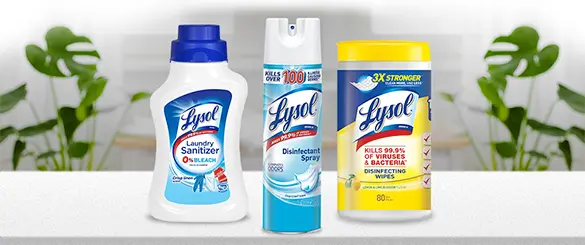
Your information is safe with us. We will only use it to deliver you content and promotions. You can unsubscribe at any time.
*ALL FIELDS REQUIRED
Help & Support
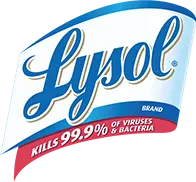
Hand Washing
Hand washing lesson plan for kids.
Students will learn that tiny germs can be spread both in the air and on surfaces. Without practicing healthy habits, such as handwashing, we risk getting sick. In this lesson, students will learn about the reasons we wash our hands, the correct way to wash our hands, and how to promote handwashing.

Download the Handwashing Lesson Plan
Hand Washing Lesson Plan
Goals and Skills
Students will:.
- Understand that germs can be spread by coughing, sneezing, or touching
- Understand that one way to help prevent the spread of germs is by handwashing
- Learn the correct procedure for washing hands
- Learn when we should wash our hands
Supplies and Preparation:
- One bowl of water per child
- Ground black pepper
- Poster paper
- Art supplies
- Video recording device (extension activity)
Background for Teachers
Visit the CDC’s Handwashing: Clean Hands Save Lives page to learn more about the spread of COVID-19 and the importance of handwashing. https://www.cdc.gov/handwashing/index.html
Instruction Steps
Washing our hands is one of the best things we can do to avoid getting ourselves or others sick. When we do not wash our hands, we spread our germs, which can make us and others sick. These germs spread quickly from one person to another through little droplets when someone coughs, sneezes, or talks.
If we touch our eyes, nose, or mouth, these droplets can enter our bodies and make us sick. When we touch different surfaces with our hands, we are also spreading our germs. These germs can remain on a surface from a few hours to several days.
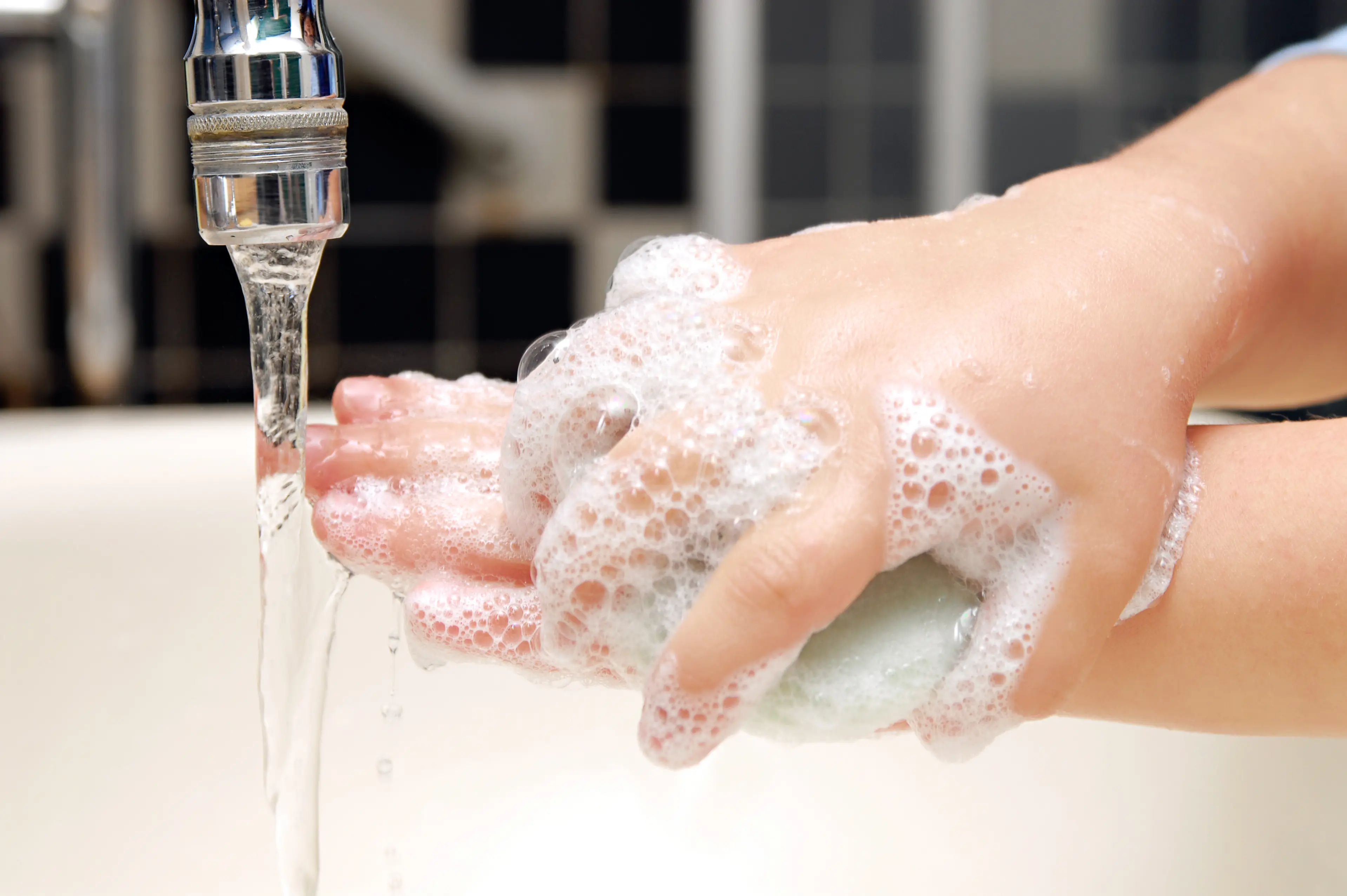
Mimic the proper handwashing steps with your hands. Have students follow along with their hands.
- Wet your hands with water and apply enough soap to be able to cover your hands
- Rub the palms of your hands together. Be sure to include in between and behind your fingers.
- Rub your hands together for at least 20 seconds (enough time to sing "Happy Birthday" twice).
- Rinse your hands with water
- Dry your hands with a paper towel and use a towel to turn off the faucet
It is especially important that we remember to wash our hands during these important times:
- Before, during, and after preparing food
- Before eating food
- After using the bathroom
- After blowing your nose, coughing, or sneezing
- After touching an animal, animal feed, or animal waste
- After handling pet food or pet treats
- After touching garbage
To teach students about the importance of handwashing and stopping the spread of germs, complete the following science experiment:
- Fill a bowl with water and add ground black pepper to the top of it
- Tell students to think of the pepper as the germs that get on our hands
- Have students place their finger in the bowl of water and make note of how the pepper (germs) stay on their finger
- Have students rinse their hands
- Then, have students place a small dot of dish soap onto their finger
- Next, have the students place their finger with soap in the bowl again
- Have students make note of how the pepper spreads. Explain that when we wash our hands with soap, the pepper (germs) does not stay on our hands.
Reinforce the idea that when we wash our hands with soap and water for the correct amount of time, we help prevent germs from spreading.
Have students create their own handwashing posters to place by the sink. Make sure they include the steps on how to properly wash their hands.
Extensions/Add-ons
If time allows, extend the lesson by creating a 20-second song that reminds students about washing hands and using soap and water. Practice singing the song with students when they wash their hands. Have students practice the song at home with their family.
Have students create a video about the importance of handwashing. Students will write a script discussing how and when to wash our hands. Have the videos played at school during announcements or in the younger students' classrooms to promote this healthly habit.
Home Connection
Talk to parents about the importance of handwashing at home. Suggest to parents that they can work with their child to create a daily chart that will keep track of how many times family members wash their hands. Discuss as a family why we wash our hands and reiterate when we should wash our hands.
Explore More Resources For COVID-19 in Schools
Related Articles

Teaching Hygiene in the Classroom

Healthy Hygiene Habits Lesson Plan for Kids

Hand Washing Games & Lesson Plan for Kids

Raise More Germ-Aware Kids: 4 Tips for Parents
DISCLAIMER:
Presented by Lysol® in collaboration with NEA and National PTA.
Education Standards: Standards: (NHES) Health 1.2.1, 1.2.3, 8.2.2, 7.2.1, 7.2.2;
(NAEA) Visual Arts: VA:Cn10.1.Ka, VA:Cn11.1.Ka; (CCSS) ELA-LITERACY with SL.K.5
For more resources, visit CDC – Stop the Spread of Germs Poster
https://www.cdc.gov/coronavirus/2019-ncov/downloads/stop-the-spread-of-germs.pdf
CDC – Be A Germ Stopper Poster https://www.cdc.gov/handwashing/pdf/294906-handwashing-superhero-boy-p.pdf
https://www.cdc.gov/handwashing/pdf/294906-handwashing-superhero-girl-p.pdf
CDC – Germs Are All Around You Poster https://www.cdc.gov/handwashing/pdf/Handwashing-Middle-School-8x11-p.pdf
CDC - Handwashing Posters https://www.cdc.gov/handwashing/posters.html
CDC- Handwashing Stickers https://www.cdc.gov/handwashing/stickers.html
- Grades 6-12
- School Leaders
FREE 2024-25 Printable Teacher Calendar! 🗓️
How To Teach Kids To Wash Their Hands So They’ll Remember It Forever
7 easy and fun ideas!
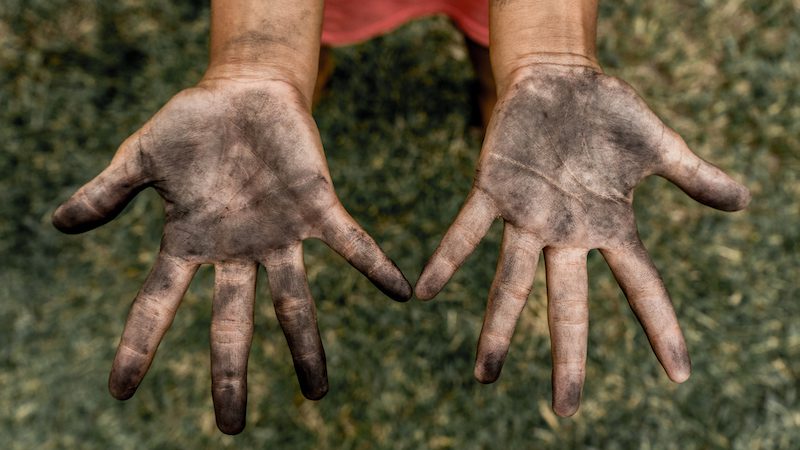
HERE for Healthy Schools by Lysol has a mission to educate about healthy habits to help kids miss less school—so they are able to learn, grow, and thrive.
Handwashing is one of the most effective ways to help prevent the spread of germs. So why are kids still so bad at it? It’s never a bad time to teach (or reteach!) kids proper handwashing procedures. Follow our advice on handwashing for kids and make the lesson stick:
Give them five easy steps to follow
Too many steps, and kids won’t remember. Teach kids to wash their hands using these five steps:
- Wet your hands with warm water.
- Lather your hands with soap.
- Scrub your hands for 20 seconds. (Remember to clean your palms, the back of your hands, between your fingers, and under your nails. Germs are good at hiding!)
- Rinse your hands under running water.
- Dry your hands with a clean towel.
Often, kids don’t scrub for long enough for handwashing to be effective. Most people teach children to sing the “Happy Birthday” song twice. However, the ABCs or “Twinkle, Twinkle, Little Star” (same tune, different words) will also work. Any song (or chorus) that lasts 20 seconds will do the trick, so feel free to get creative! Check out Wash Your Lyrics to turn any song into a handwashing infographic.
Make it fun
Kids are more engaged with any process when there’s a fun factor. Get a kid-friendly dispenser. You can also up your bar soap game. Follow these directions from Hello Glow to make your own glycerine soap with a “treasure” inside. Kids will be scrubbing like crazy to get to the hidden toy!
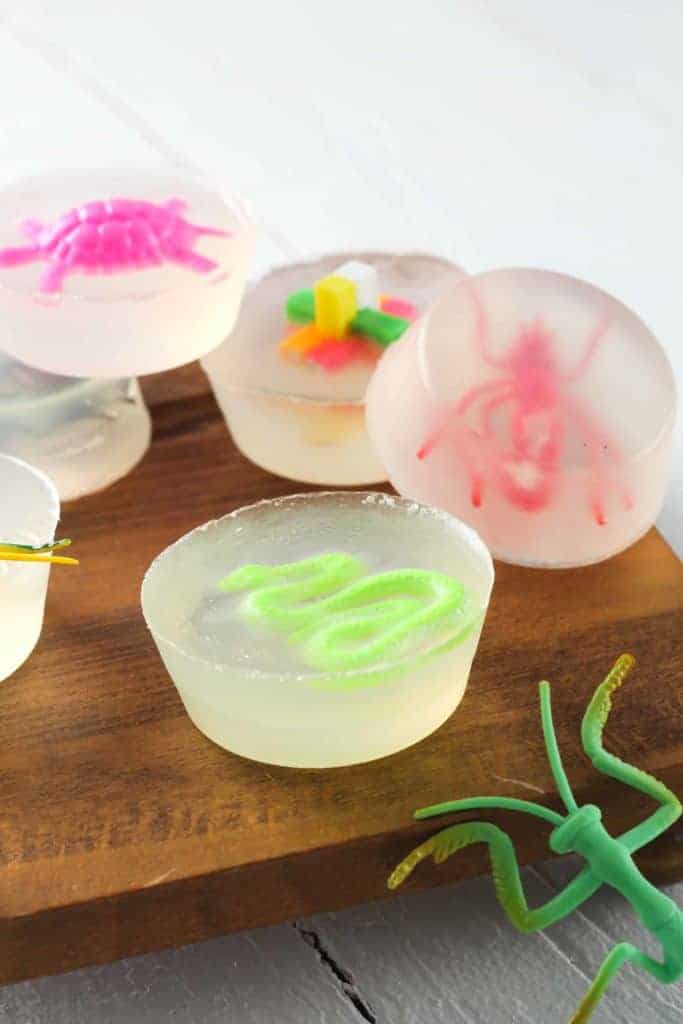
Source: Hello Glow
Be a good role model
Kids look to the adults around them to set the standard. By washing your hands frequently throughout the day, you set a powerful example. You model the proper technique, but you also show that you think the task is a valuable one.
Remind them often
Children need frequent reminders to wash their hands. It’s easy to remember when you can see the dirt on your hands, but germs are invisible to the naked eye. Prompt them throughout the day and emphasize handwashing at certain times. For example, kids should wash their hands before eating, after using the restroom, after blowing their nose, and when coming in from outside.
Provide a contingency plan
Teach kids that washing their hands is the most effective way to help prevent the spread of germs. However, they should also know what to do when soap and water aren’t available. In that case, they can use an alcohol-based sanitizer. Parents should supervise its use and make sure the sanitizer is at least 60% alcohol, as recommended by the Centers for Disease Control.
You Might Also Like
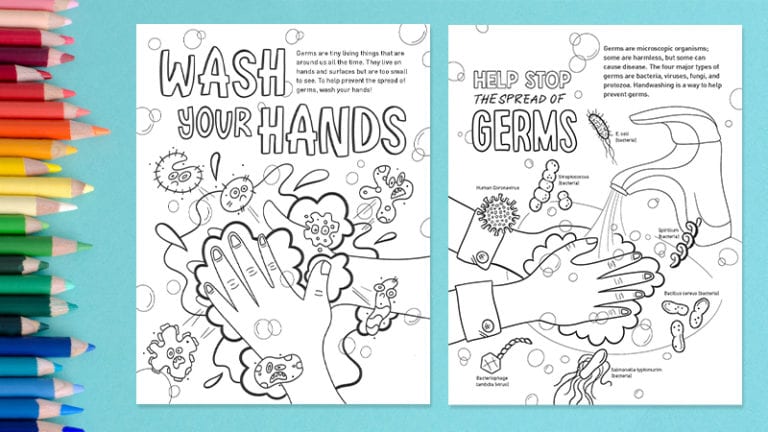
Free Germ Coloring Pages: For Cute and Fun Germ Education
One each for Grades K-2 and Grades 3-5! Continue Reading
Copyright © 2024. All rights reserved. 5335 Gate Parkway, Jacksonville, FL 32256

7 Activities For Teaching Personal Hygiene To Elementary Students
Imagine a world where brushing teeth, washing hands, and taking care of personal hygiene are not only important but also incredibly fun and exciting! In this world, students eagerly anticipate hygiene lessons and look forward to discovering new and creative ways to stay healthy and clean.
Therefore, activities are a great way to promote good hygiene habits and also help students develop important life skills such as critical thinking, problem-solving, and creativity. So, let’s explore the world of personal hygiene together and discover the many exciting and creative ways to stay healthy and clean!
Personal hygiene activities for elementary students
Promote good hygiene habits and have fun doing it with these 8 creative and engaging personal hygiene activities for elementary students.
1. Germ detection experiment

Have you ever wondered how germs spread and how we can get rid of them? Today, we’re going to conduct a fun experiment to show you how proper handwashing can remove germs!
For this activity, begin by explaining to the students the importance of proper handwashing and how it can prevent the spread of germs. To illustrate the concept, turn off the lights and turn on the blacklight to create a ‘germ zone’ in the classroom. Next, apply the glowing lotion to your hands and encourage the students to do the same. After that, have the students touch different surfaces in the classroom to spread the ‘germs.’ Finally, ask the students to wash their hands thoroughly and use the blacklight again to see how many germs they removed.
2. Interactive story time

Who loves stories? Today, we have a special story about the importance of personal hygiene. But we’re not just going to read it, we’re going to act it out together!
In this activity, begin by selecting a children’s storybook that emphasizes the importance of personal hygiene. As you read the story, ask the students to act out different hygiene activities like brushing their teeth, washing their hands, and combing their hair. You can make it more interactive by asking the students to freeze and do their best impression of a germ when they hear the sound of a bell. This will help to keep the students engaged and reinforce the importance of good personal hygiene.
3. Hygiene scavenger hunt

Are you ready for a challenge? We’re going on a hygiene scavenger hunt! You’ll need to find different items around the classroom or school that are important for personal hygiene. Who’s ready to find some toothbrushes and soap?
To begin the scavenger hunt, create a list of personal hygiene items that can be found around the classroom or school, such as toothbrushes, soap, and hand sanitizer. Then, give each student a copy of the list and a pair of goggles that blur their vision. Set a time limit of 5 minutes and ask the students to work with a partner to find as many items as they can and bring them back to the starting point. This activity will not only help the students to identify different hygiene items but also promote teamwork and cooperation. Furthermore, this is also a fun team-building activity for kids.
4. Germ art project

Are you ready to get creative and learn about germs at the same time? Today, we’re going to make a germ art project! You’ll use construction paper, markers, and glitter to create your own germs. And then, you’ll explain how proper hygiene can prevent the spread of germs.
Start this activity, by providing each student with construction paper, markers, and glitter to create their own unique germs. Encourage them to use their imagination to draw different shapes and colors, and then sprinkle some glitter to make them sparkle. When they’re done, ask each student to explain to the class how proper hygiene can prevent the spread of germs.
5. Hygiene charades

Let’s have some fun while learning about personal hygiene! Today, we’re going to play hygiene charades. You’ll act out different personal hygiene activities while your classmates guess what you’re doing. Who’s up for the challenge?
To begin this activity, ask each student to act out different hygiene activities like flossing their teeth or using hand sanitizer. But here’s the catch – they can’t talk! Their classmates will have to guess what they’re doing based on their actions. This activity will not only promote physical activity and teamwork but also reinforce the importance of good personal hygiene.
6. Hygiene quiz show

Are you ready to test your personal hygiene knowledge? Today, we’re going to play a hygiene quiz show. You’ll answer questions about handwashing, toothbrushing, and more. Who will be the hygiene champion?
To begin this activity, create a list of questions related to personal hygiene, such as how long to brush your teeth or the importance of handwashing. Divide the students into teams and provide them with a buzzer. Each team will have 30 seconds to answer each question, and the first team to hit the buzzer gets to answer. Be sure to provide prizes to the winning team.
7. Personal hygiene reflection journal
Do you want to reflect on your personal hygiene habits and set goals for improvement? Today, we’re going to start personal hygiene tracking. You’ll track your daily hygiene routine and how you can make changes to keep yourself healthy and happy.
To begin, provide each student with a hygiene tracker where they can mark down their daily hygiene activities, such as brushing their teeth, washing their hands, and taking a bath or shower. Encourage the students to decorate their trackers in a fun and creative way, such as coloring or adding stickers to represent their favorite hygiene activities.
Each day, have the students mark down the hygiene activities they completed on their trackers. At the end of each week, have a class discussion where students can share their progress and set goals for improvement. Encourage the students to support each other and celebrate their accomplishments. You can also provide incentives , such as stickers or small prizes, for students who consistently complete their hygiene activities.
Personal hygiene activities can be a fun and engaging way to teach elementary students about the importance of good hygiene habits. By providing creative and interactive experiences, students can learn about the science behind germs, develop art skills, and practice important life skills such as critical thinking and problem-solving. Hence, these activities are great critical thinking activities too.
Furthermore, by promoting personal hygiene habits early on, students can develop healthy habits that will stay with them for life. So, let’s continue to explore the world of personal hygiene together and make it an exciting and enjoyable experience for all!

I am Shweta Sharma. I am a final year Masters student of Clinical Psychology and have been working closely in the field of psycho-education and child development. I have served in various organisations and NGOs with the purpose of helping children with disabilities learn and adapt better to both, academic and social challenges. I am keen on writing about learning difficulties, the science behind them and potential strategies to deal with them. My areas of expertise include putting forward the cognitive and behavioural aspects of disabilities for better awareness, as well as efficient intervention. Follow me on LinkedIn
Leave a Comment Cancel reply
You must be logged in to post a comment.

Hand-Washing: A Weapon Against Germs!
Young people will learn when hand-washing is essential and will be able to demonstrate proper and effective hand-washing techniques.
9-14 Years Old
What You Need
- Internet access to view a video on hand-washing created by the Centers for Disease Control and Prevention
- Preservative-free bread (fresh bakery bread)
- Zip-lock sandwich bags
- Permanent markers
Healthy Families Newsletter
English (pdf)
Spanish (pdf)
To find out how this health safety lesson fits Physical Education and Health Education standards click here .
Newsletter sign-up
Be the first to know when new lessons come out.

Lesson Overview
This lesson helps young people understand the importance of hand-washing by showing them firsthand how everyday germs start out invisible, but when left unattended grow into something very unappealing. They will review proper hand-washing techniques.
Instructor Notes
Before facilitating this lesson, you may want to review the following information about hand-washing. These facts can be shared with young people during your discussions.
Hand-washing is easy to do. It’s one of the most effective ways to prevent the spread of many types of germs in all settings—from your home and workplace to schools and more. Clean hands can stop germs from spreading from one person to another.
When should we wash our hands? You should always wash your hands:
- before, during, and after preparing food
- before and after eating food
- before and after caring for someone who is sick
- after using the toilet
- after blowing your nose, coughing or sneezing
- after touching an animal
- after touching garbage
- any time they feel or look dirty.
It seems simple and obvious that it’s important, but according to the American Society of Microbiology, 96 percent of people say that they wash their hands after using a public restroom, but during observations conducted as part of a study, only 93 percent of females and 77 percent of males actually do.
Introduction
Fifty percent of young people in middle and high school wash their hands, and of these, only 33 percent of females and eight percent of males use soap. That makes it even more important to wash hands since so many of the same people are touching door handles, tabletops, computer keyboards and so many other things every day.
- Show the video Wash Your Hands by the Centers for Disease Control and Prevention. (The 30 seconds long.)
- Wet your hands with clean running water (warm or cold). Apply soap.
- Rub your hands together to make a lather. Scrub them well. Be sure to scrub the backs of your hands, between your fingers, and under your nails.
- Continue rubbing your hands for at least 20 seconds.
- Rinse your hands well under running water.
- Dry your hands using a clean towel or paper towel. You can also let your hands air dry.
- Alcohol-based hand sanitizers can quickly reduce the number of germs on hands in some situations, but they do not remove soil and other substances and do not eliminate all types of germs.
- Also, alcohol-based hand sanitizers are not good at removing elements of food for those who suffer from food allergies. A child or adult with a severe food allergy could have a reaction if someone else near them has not washed their hands with soap and water and comes in contact with that person.
- Remind young people that good hand-washing is one sure way to keep you and others in good health!
Activity: A Slice with Germs
- Ask young people to touch their faces, hair, desk or other object to get their hands dirty.
- Give each young person a slice (whole or half) of preservative-free, fresh bakery bread and tell them to touch it all over, keeping it flat.
- Have young people place the slice of bread in bag with two small drops of water. Seal the bag shut.
- Label the bag with the young person’s name and date.
- Put all the bread slices in a brown grocery bag. Include one piece of bread in a bag that was untouched.
- Seal the grocery bag shut. Place in warm spot.
- Each day, have the youth open the brown grocery bag and observe the bread for any changes. Typically it takes about five days to two weeks for good mold growth.
- Explain to the youth that the mold is from the germs they had on their hands. Even though we can’t see these germs, they are there. These germs can spread easily and cause us to become sick.
- Hand-washing is the simple most effective way to reduce the number of germs on our hands!
Remind young people that hand-washing is the simple and effective way to reduce the number of germs on our hands. Picture the mold your germs grew on the bread to remember how important it is to wash your hands throughout the day!
Continuing the Conversation
Hand out the Healthy Families Newsletter in English or Spanish , so that families can continue discussing good hand-washing habits at home.
Related Health Powered Kids Blog
Practicing good hand-washing techniques will help keep germs away
Additional Instructor Resources
Infection Prevention: Hand Washing video

Power Chargers
A set of quick activities to ignite bursts of energy. See all >
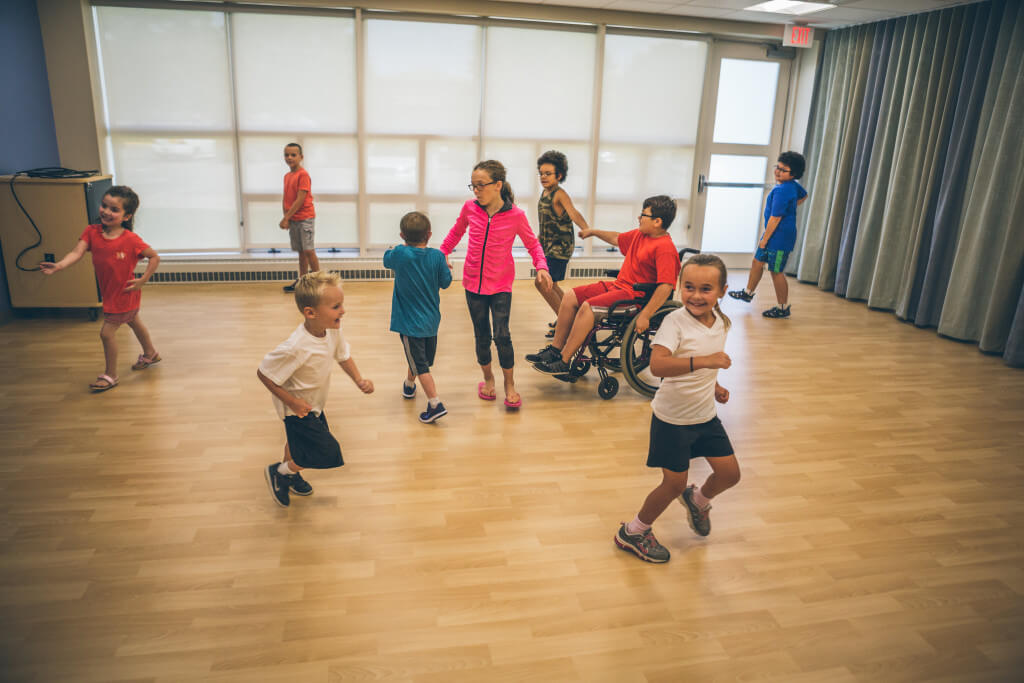
Food and Fitness Freeze Frames
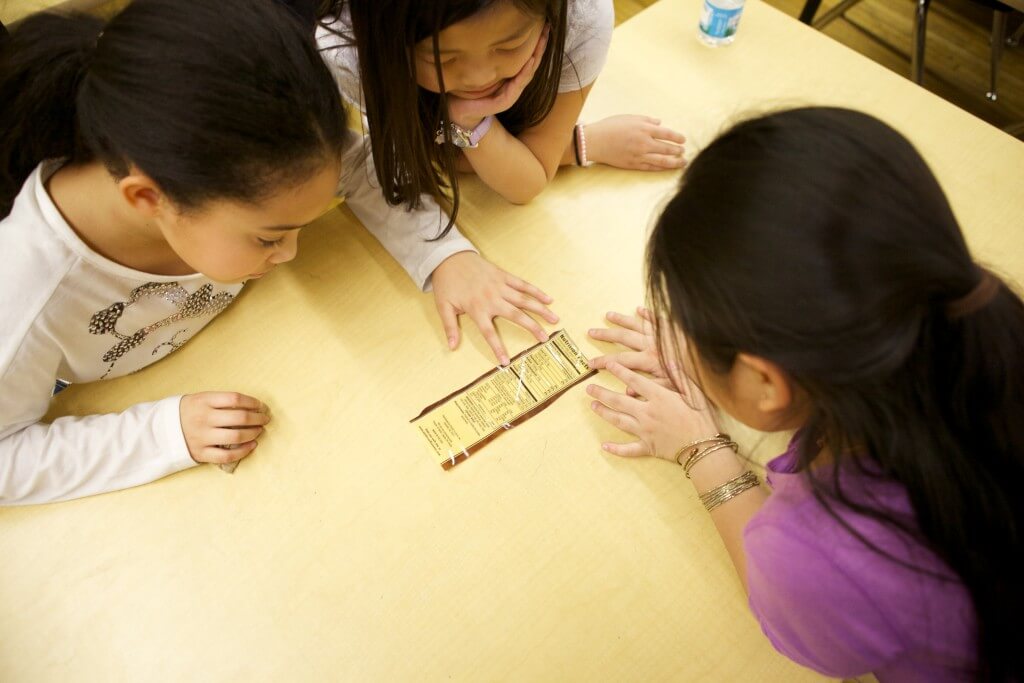
Label Decoder
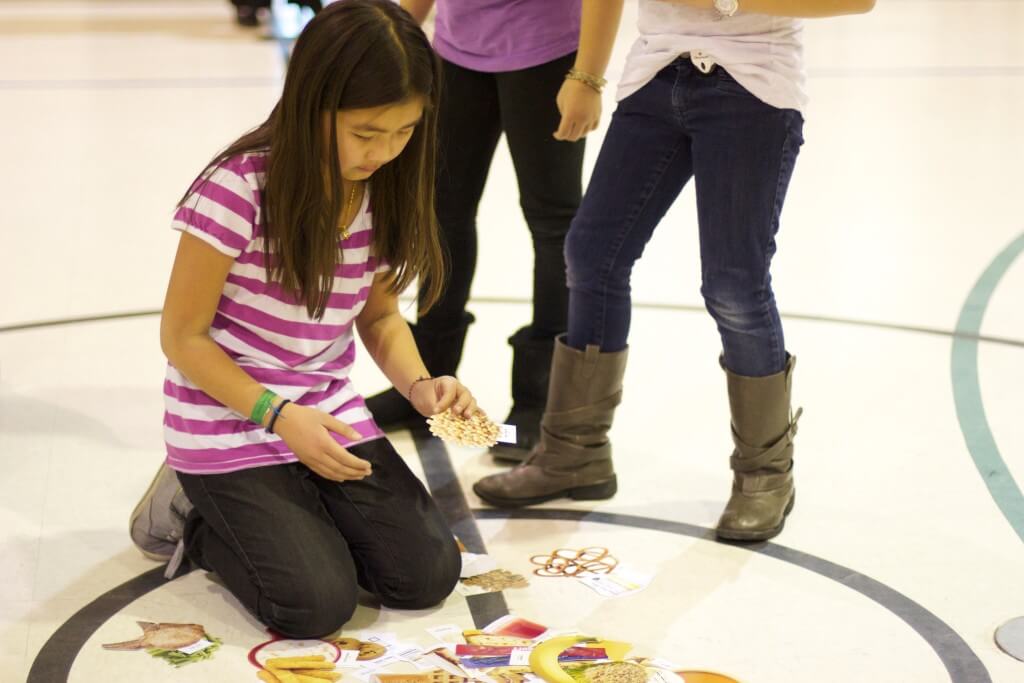
Secret Food and Fitness
This site is presented for information only and is not intended to substitute for professional medical advice. Health Powered Kids is a trademark of Allina Health System. Presentation and Design © 2015 Allina Health. All Rights Reserved.

Got any suggestions?
We want to hear from you! Send us a message and help improve Slidesgo
Top searches
Trending searches

6 templates

indigenous canada
9 templates

121 templates

education technology
232 templates

39 templates

29 templates
Personal Hygiene Habits for Kids
It seems that you like this template, personal hygiene habits for kids presentation, free google slides theme, powerpoint template, and canva presentation template.
How often should we bath? And clean our hands? Must we brush our teeth every time we eat? Learning personal hygiene can be fun for kids if you explain good habits to them with this fun presentation full of illustrations and creative resources. Turn bath time into fun time thanks to the cute stickers in these slides and prepare a lesson to speak about how we should keep clean!
Features of this template
- 100% editable and easy to modify
- 35 different slides to impress your audience
- Contains easy-to-edit graphics such as graphs, maps, tables, timelines and mockups
- Includes 500+ icons and Flaticon’s extension for customizing your slides
- Designed to be used in Google Slides, Canva, and Microsoft PowerPoint
- 16:9 widescreen format suitable for all types of screens
- Includes information about fonts, colors, and credits of the resources used
How can I use the template?
Am I free to use the templates?
How to attribute?
Attribution required If you are a free user, you must attribute Slidesgo by keeping the slide where the credits appear. How to attribute?
Related posts on our blog.

How to Add, Duplicate, Move, Delete or Hide Slides in Google Slides

How to Change Layouts in PowerPoint

How to Change the Slide Size in Google Slides
Related presentations.

Premium template
Unlock this template and gain unlimited access

Register for free and start editing online
- Teaching Hand Hygiene
- Teaching Home: Curricula
- Build A Tool Kit
- Project Ideas
- Children’s Books
Hand Hygiene
- Hand Hygiene Home
- Soap and Water
- Hand Sanitizer
- Why and When
- Choosing and Using Soap
- For Schools and Child Care
- For Food Handlers
- For Health Care Professionals
- Posters and Print Materials
Related Topics
- Food Safety
- Cover Your Cough
- Infection Control
Contact Info
Hand washing project ideas for students.
A list of fun and educational project ideas for students of all ages to teach about the spread of germs and handwashing.
On this page: Art Drama Language Arts Music Science Student Outreach Community Outreach Media
- Bulletin board at local health department and exhibit at the shopping mall.
- Sponsor a school poster contest after educational session presented to student classrooms.
- Make hand washing puppets for demonstration to younger students.
- Provide disposable cameras to school students. Have them take pictures at home of when people should wash their hands. Collect the cameras, develop the film, selected the "best" pictures, enlarge them and have them laminated for placemats. Placemats can be given to local restaurants not only as an educational tool, but a real conversation piece! Or, photos can be made into a "community calendar."
- Create a costumed "character" and have the character appear at schools/parades.
Language Arts
- Students keep hand washing diary for one week.
- Publish information in school newsletter.
- Students write a short essay. Publish the essays in the local paper. Have them "judged".
- Compose a hand washing song to the melody of Old MacDonald Had a Farm; Row, Row, Row Your Boat; or Happy Birthday.
- Conduct educational session on the topic of hand washing behavior and disease transmission to high school science classes.
- Have students swab common school surfaces and grow the specimens in petri dishes. Also touch fingers on petri dishes.
- Measure "before" and "after" effectiveness of hand washing training efforts by using the Glitter Bug Potion. (The lotion will "glow" if students haven’t thoroughly washed their hands.)
- Compute an average absenteeism rate for students or group due to illness. Conduct hand washing education and have students wash their hands up to four times each day. Measure absenteeism rate after the project.
- Perform a pre-and post-test on educational seminar participants to illustrate program effectiveness.
Student Outreach
- Older students teach younger students hand washing technique.
- Unobtrusively observe and record length of time students wash hands before and after hand washing education session. Tie promotions into National Public Health Week during the month of April.
- Do a "Hand Washing Team Shadow Program" where students work one-on-one with school nurse, food service director, janitor in planning logistical ways to integrate hand washing and disease prevention into the school.
Community Outreach
- Place cable TV crawl message on the public access community channel.
- Include a hand washing message on statements to city utility customers.
- Clean Hands website link on school web home page.
- Commission billboards to spread the message in the area.
- County Fair display with educational materials, and a sample bar of soap to get them started! Distribute materials at Women, Infant and Children (WIC) and immunization clinics, ambulance services and local nursing colleges.
- Exhibit at Health Fairs.
- Place hand washing signs in public restrooms across town.
- Present to pre-schools, daycares, elementary schools, association of home-school students, 4-H groups and at local festivals.
- Target special audiences — homeless shelters, churches, day camps, home health agency staff, emergency response teams, animal shelter staff, zoos, juvenile detention centers or vendors at fairs and festivals.
- PTA/PTO presentation to educate parents
- Announcements on daily school PA broadcasts.
- Develop a video on hand washing and in another language.
- Provide on-air radio and TV and newspaper interviews.
Project Sources
- Kansas Department of Health and Environment
- hand hygiene
Subscribe for posts, freebies & updates!
Emily Education
Educational Resources
Fun Activities for Teaching Hand Washing
Let’s face it, any time a group of littles gathers together in one place there will be germs. Lots of them! But that does not mean that we have to become the victim to those pesky, microscopic creatures that cause all sorts of illnesses. Nope! We can take control of our classrooms and be proactive. Here’s some of my favorite classroom activities for teaching hand washing and minimizing the spread of germs in the classroom.
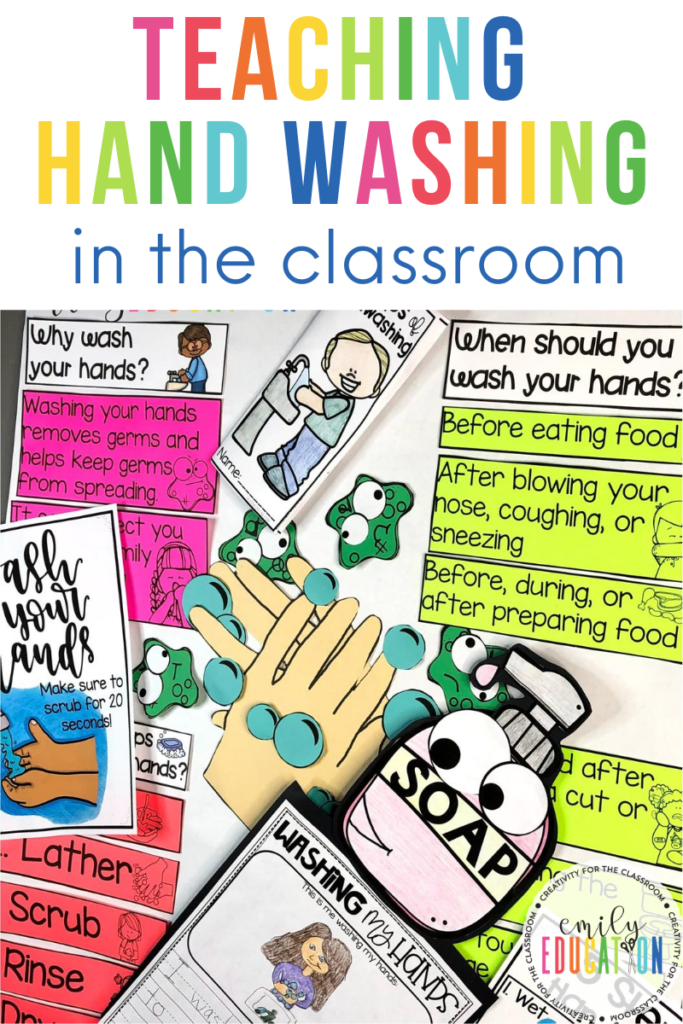
1. Go on a Germ Hunt

A germ hunt is a fun way to get your students interested in learning about good hygiene. Start in the classroom and ask students to identify some places they think germs can be found. Students are very likely to identify obvious places like the bathroom and the trashcan. But, they may be surprised at many other places like their desk top, pencils, and door handles. You can also walk through the school and identify places that might have germs in the school building and on the playground.
Do this as a discussion activity or have students make this germ craft before you begin. As students identify a place in the classroom or school where germs would be found, let them tape their germ on the item. This creates a really good visual for just how prevalent germs are in our environment.
This video by WonderGrove Kids is a great follow-up activity to a germ hunt. After watching the video ask your students if there are any other places they missed that should be labeled with germs.
2. Hand Washing Activities
After introducing the concept of germs, teaching your students about hand washing is a great next step. After all, the Center for Disease Control says that “regular hand washing is one of the best ways to remove germs, avoid getting sick, and prevent the spread of germs to others.” If you want to know or teach about the reasons why , or even look at the scientific data to support this statement you can find it all on the CDC website!
Teaching students good hand washing techniques does not have to be boring. In fact, it can be really fun, engaging and interactive.

Hand Washing Anchor Chart
I love, love, love anchor charts because they are such a valuable learning tool during a lesson and after. This hand washing anchor chart is no exception. Not only do the students love building it, but it gives us a great opportunity to really dig into the whys, whens and hows of hand washing. You can create this all in one day, or add a little each day as you learn about germs and hand washing.

As we create the anchor chart we work on the 5 steps to good hand washing. I also love to teach this song to my students. Not only does it remind them what to do, but by singing it while they wash their hands, they can make sure they are washing for the recommended 20 seconds.
After we create the anchor chart together, we review what we learned with this tri-fold reader.
Hand Washing Reader
I tell you, nothing makes my students feel more “grown up” than reading. Adding a reading component to any lesson is a great way to create cross-curricular learning for anything – even hand washing.
This tri-fold hand washing reader is the perfect way for students to read and re-read the important steps in hand washing.
A Digital Sorting Activity
Sometimes connecting learning to technology skills can be difficult. I really love using SeeSaw and Google Slides activities to help my students learn and review academic skills while practicing important technology skills. Both of these platforms allow my students to work on things like using a mouse, hand-eye coordination, and how to drag and move digital elements.
In this digital activity, students can read about hand washing and then sort the hand washing steps into the proper order.
A Hand Washing Writing Activity
Writing is a wonderful way to pull a lesson or topic together. It gets our students thinking about what they learned and using the vocabulary as they write about it. Many times, writing requires our students to use higher level thinking skills as they analyze and apply what they have learned.

While my students aren’t quite ready for a doctoral thesis they do love a good writing craft! Adding a simple craft not only engages them in writing, but it also makes a great writing display and keepsake.
This hand washing writing activity is so versatile. You can allow students to write whatever they would like based on what they learned about hand washing and germs. Or, provide a writing prompt that helps them practice different types of writing. Here’s some ideas:
- Pretend you were a germ and were about to get washed down the drain (Creative Writing / Narrative Writing)
- How to Wash Your Hands in 5 Steps (How To Writing)
- Germs are Everywhere (Expository Writing)
- Why it’s import to wash you hands (Persuasive Writing)
There are so.many.possibilities!
3. A Hand Washing Experience
After learning all about germs and hand washing, a great way to wrap-up your unit is with a hand washing experience. I’m talking about hands-on hand washing!
Both of these activities are great visual examples of how germs transfer from person to person and person to surface. They are also great to see how effective hand washing is in getting rid of germs.
Shine a Light on Germs
Have you ever seen the black light hand washing lesson? It’s a wonderful activity that allows students to see the germs that would be otherwise invisible.
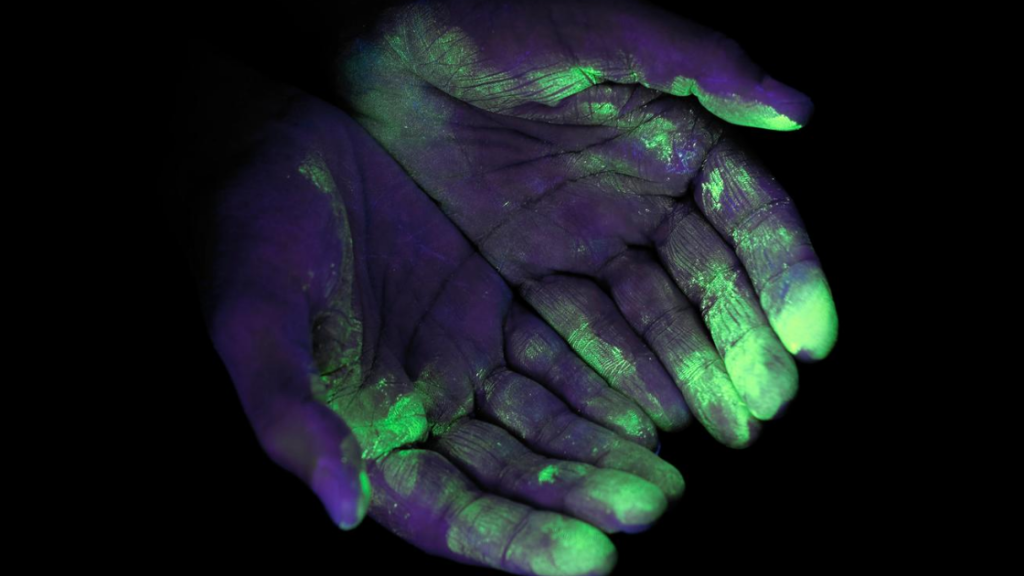
Here’s the idea: Using a special lotion or powder, you rub a small amount all over your hands. Then turn off the lights and hold your hands under a black light. The areas that glow are areas where there are germs.
You can then go about your day and do some of your ordinary activities. Later checking the people around you and the surfaces in the room for germ transmission. You will be amazed at all the germs that start to glow around the room. Yuck!
Finally, go wash your hands. After washing, it’s time for one more visit under the black light to see just how many germs are gone. It is a great way for students to visualize what hand washing does. It’s also a great way for them to see areas they might have missed when washing (like between the fingers or near the wrist).
The school nurse or health teacher often has a black light hand washing kit. If not, then check out GloGerm to see the variety of kits they have available.
Hand Washing and Glitter
If you don’t have a black light kit available, or want to try something different then here’s an inexpensive activity that only needs baby oil or lotion, glitter and soap.
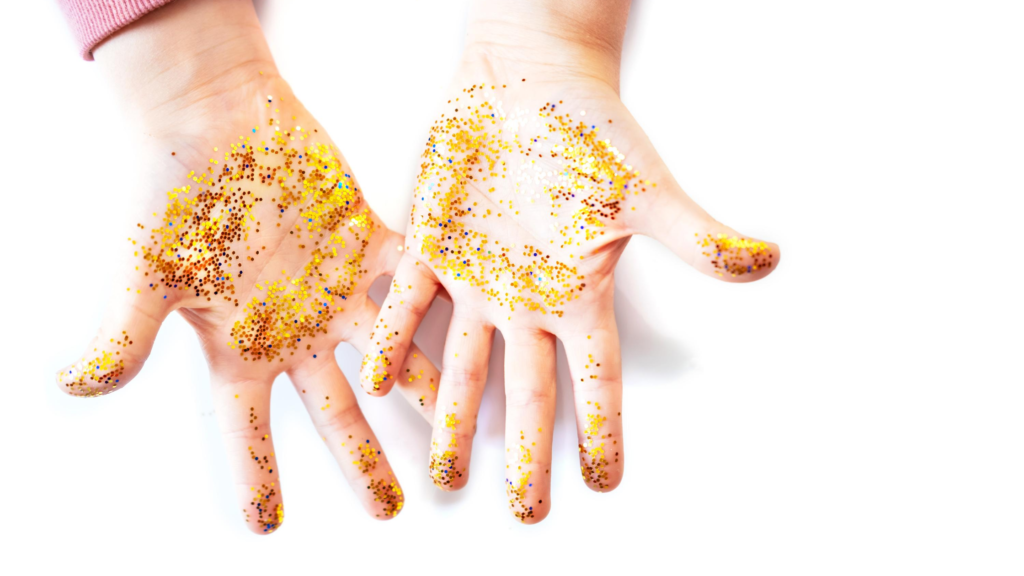
First rub a little baby oil or lotion on your hands – then add the germs, I mean the glitter. Not only is this fun but its a great way for the students to see the germs.
Check out what to do next (or watch this video from the Indianapolis Children’s Museum with your class.)
If you do this in the classroom, I would suggest only “germing” about 1/3 or 1/2 of your students. Then let your students mingle and see just how easy it is transfer germs from person to person and surfaces in the classroom.
Tip: When you are done, do a quick check around the room and then challenge the students to see if they can clean the germs from the classroom too! You might find glitter for a few days but each time you do it will be a good visual reminder of your germs and hand washing lessons.
Teaching Hand Washing is Fun and Easy
As you can see, these lessons on germs, germ transmission and hand washing are lots of fun. They are really engaging for the students too! Choose one or do them all. You can find all the printable hand washing activities in my store at Teachers Pay Teachers. It’s definitely a resource you will use year after year!

Don’t Lose This Page!
Don’t lose this page and these engaging activities in the vastness of the internet. Simply pin this to your favorite classroom Pinterest board so you can come back for ideas on teaching hand washing and many other things!
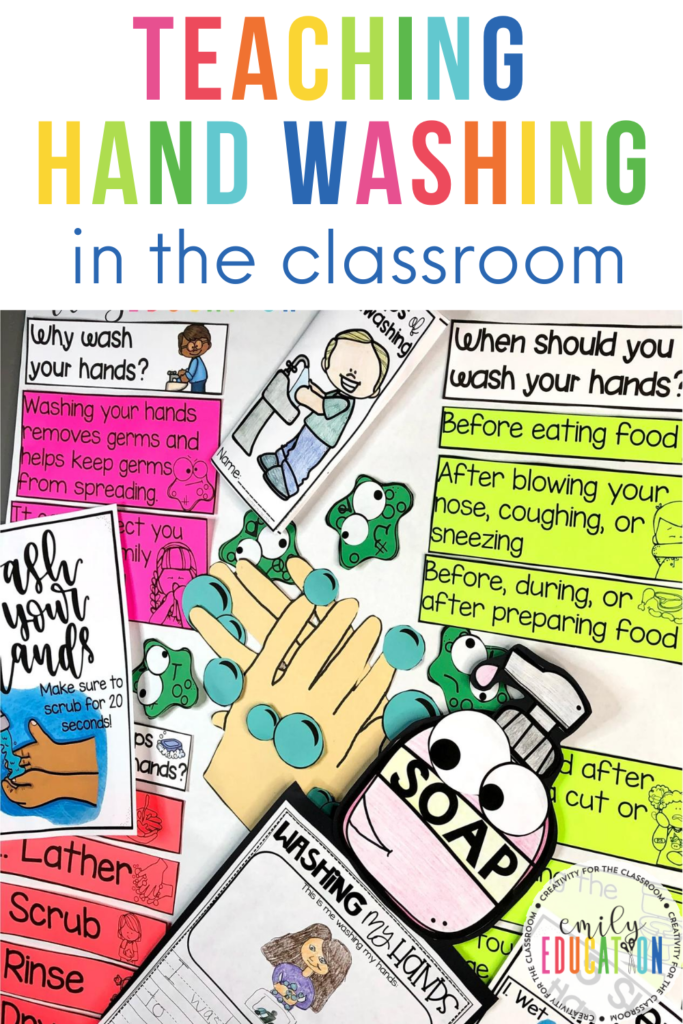
Latest on Instagram
Latest on facebook.
8 months ago

Share on Facebook Share on Twitter Share on Linked In Share by Email
9 months ago
1 years ago

IMAGES
VIDEO
COMMENTS
Hand washing presentation. Nov 8, 2016 • Download as PPT, PDF •. 59 likes • 79,975 views. AI-enhanced description. AbdullahallAraf. This document provides information on hand washing and hygiene. It discusses who should practice hand hygiene, what hand hygiene is, where it should take place, why it is important, when it should be ...
This video was created to teach kids about hand washing and why it is important. The goal is to decrease the rate of infection by encouraging kids to wash th...
This Google Slides and PowerPoint template has been designed to teach children the importance of proper hand hygiene in a fun and practical way. With colorful visuals, step-by-step instructions, and engaging activities to check understanding, this template will make learning about hygiene a breeze. From singing songs to understanding how germs ...
Classroom Presentation. Our presentation is a 15 -20 minute demonstration of the 4 Principles of Hand Awareness. A goal is to help children understand that clean hands are important to good health. Children at this age are able to protect their own bodies, and we want them to develop a greater awareness of the role our hands play in the spread ...
Reinforce the correct way to wash hands with our Washing Hands PowerPoint. Download and present this resource for students to understand how to wash hands correctly. It's a helpful breakdown of all the key steps involved in handwashing, and why it's so important for staying healthy, all with friendly and engaging illustrations to help children visualise the process - perfect for younger ...
Make your child feel good about hand washing by tying it to fun activities such as snack time and cleaning up from arts and crafts. Have your child practice counting or sing a song while they wash their hands, to make sure they do not rush. Soap or sanitizer that foams, changes color or smells good can be exciting for kids as well. One of the ...
5. Have the student wash hands for five seconds. Stop and check the cleanliness of the hands under the black or UV light. Record this as "5 seconds." 6. Have the student wash hands for five additional seconds. Stop and check under the black or UV light. Record this as "10 seconds." 7. Repeat the procedure twice more, for 15 and 20 seconds.
Encourage students to make their posters bright and interesting so that people will be encouraged to wash their hands correctly, as often as possible. Independent practice Have students draw posters that show all the steps to washing hands and/or show all the reasons why it is important to wash hands correctly, such as COVID-19 and flu prevention.
Have students follow along with their hands. Wet your hands with water and apply enough soap to be able to cover your hands. Rub the palms of your hands together. Be sure to include in between and behind your fingers. Rub your hands together for at least 20 seconds (enough time to sing "Happy Birthday" twice).
Give them five easy steps to follow. Too many steps, and kids won't remember. Teach kids to wash their hands using these five steps: Wet your hands with warm water. Lather your hands with soap. Scrub your hands for 20 seconds. (Remember to clean your palms, the back of your hands, between your fingers, and under your nails.
Next, apply the glowing lotion to your hands and encourage the students to do the same. After that, have the students touch different surfaces in the classroom to spread the 'germs.'. Finally, ask the students to wash their hands thoroughly and use the blacklight again to see how many germs they removed. 2.
Review the steps covered in the video and the simple directions below for proper hand-washing. Wet your hands with clean running water (warm or cold). Apply soap. Rub your hands together to make a lather. Scrub them well. Be sure to scrub the backs of your hands, between your fingers, and under your nails. Continue rubbing your hands for at ...
This document provides guidelines for proper hand hygiene. It explains that hand hygiene includes handwashing with soap and water, use of alcohol-based hand rub, and surgical antisepsis. Regular hand hygiene is important for removing dirt, transient bacteria, and preventing the spread of infection. The guidelines list 10 situations that require ...
Learning personal hygiene can be fun for kids if you explain good habits to them with this fun presentation full of illustrations and creative resources. Turn bath time into fun time thanks to the cute stickers in these slides and prepare a lesson to speak about how we should keep clean!
Educational video for children to learn several personal hygiene habits. Apart from washing our hands, there are other personal hygiene habits essential to l...
This presentation covers proper hand hygiene and washing technique. It notes that 76 million foodborne illnesses occur annually, with 70% caused by improper hand washing. ... This document contains instructions for students to conduct a survey about hand washing habits. Students are asked to make a tally chart to track how often their ...
Tell students: What you see on my hand is actually a powder I put on my hand. Let's pretend it that it is a germ that can make someone sick. Imagine I came to school today not feeling well and sneezed into my hand. Now I have those "germs" on my hand. Let's see who else has germs on their hands. Have the students all put out their hands.
Conduct educational session on the topic of hand washing behavior and disease transmission to high school science classes. Have students swab common school surfaces and grow the specimens in petri dishes. Also touch fingers on petri dishes. Measure "before" and "after" effectiveness of hand washing training efforts by using the Glitter Bug Potion.
Here's some of my favorite classroom activities for teaching hand washing and minimizing the spread of germs in the classroom. 1. Go on a Germ Hunt. A germ hunt is a fun way to get your students interested in learning about good hygiene. Start in the classroom and ask students to identify some places they think germs can be found.
This presentation covers proper hand hygiene and washing technique. It notes that 76 million foodborne illnesses occur annually, with 70% caused by improper hand washing. Key points included the importance of hand washing after using the bathroom, changing diapers, touching animals, before eating or food preparation, and after coughing/sneezing.
Proper hand washing involves wetting hands with warm water, lathering with soap and scrubbing for 15 seconds, rinsing, and drying hands completely. Hands should be washed before eating, after using the bathroom, and when caring for sick people to limit the transfer of bacteria and viruses. Barriers like obstructed sinks can make proper hand ...
Reinforce the correct way to wash hands with our Washing Hands PowerPoint. Download and present this resource for students to understand how to wash hands correctly. It's a helpful breakdown of all the key steps involved in handwashing, and why it's so important for staying healthy, all with friendly and engaging illustrations to help children visualise the process - perfect for younger ...
Hand washing. Oct 24, 2013 • Download as PPTX, PDF •. 182 likes • 191,923 views. AI-enhanced description. Society for Microbiology and Infection care. This document discusses the importance of hand hygiene in healthcare settings. It states that healthcare-associated infections (HCAIs) place a significant disease and economic burden on ...